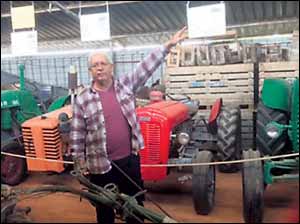 | |
| Erez’s passion for tractors | |
However, Israeli Erez Milshtein’s collection of real McCoy tractors and other agricultural equipment comes in all shapes, sizes, colours and of varying veteran status. The scores of red, green, blue, orange and yellow retired from active duty metallic workhorses today rest side by side, all spruced up and in full working order. They stand, like proud sentinels of the past, spread out neatly over an enormous footage of floor space in a huge hangar- like building, dedicated to their illustrious rich ploughing and reaping past, the museum appropriately situated in the centre of lush farmland, surrounded by orchards in Milshtein’s home at Moshav Ein Vered in the Sharon Valley. Growing up in Caerphilly, South Wales in an area surrounded by mountains, sheep and working farms, and throughout my 50 years living in a kibbutz -— 15 of them working in a then 350 head dairy farm — a lifetime ‘thing’ about tractors developed. With five kibbutz-born children growing up in the 1970s and 80s, a bumpy tractor ride with their dad at the wheel was always something they, and their mother by the way, eagerly sought of an afternoon! When the opportunity to visit Milshtein’s museum with a group of older members of Mishmar HaEmek was presented, I was delighted. Now what could be better? Not only to visit the museum, a long time on my things-to-do list, but to do so with retired members of our kibbutz community for whom the exhibition would be a true walk back into their mostly agricultural working pasts. That assumption was more than correct as even before arrival at Ein Vered they were already avidly reminiscing about their decades of ploughing fields, sowing seeds, harvesting the results of their hard labour whilst operating somewhat ancient to modern tractors and other heavy agricultural machinery, toiling hours out in the mid-day sun. Erez Milshtein is one of the best-known collectors of tractor and agricultural equipment in Israel and the Ein Vered collection became a registered not for profit association in 2003. Almost instantly upon entering the historical world of tractors and associated agricultural equipment, visitors are bowled over by the sheer scale of the exhibited items as they stand in rows, silent witnesses to, and in honour of, the development of machinery that assisted the Zionist pioneer human work horses turn swamps into arable farm land and make the desert bloom. Milstein’s passion and enthusiasm, coupled with his incredible vast knowledge of the history of each item — many of which were found rotting and rescued from disused orchards, rubbish dumps under piles of junk in disintegrating barns of kibbutzim and moshavim — is truly overwhelming. Leading the group of old farm hands from exhibit to exhibit, explaining where, how and when found and lovingly restored by him and his dedicated band of volunteer mechanics, electricians, metalworkers and more, the Jezreel Valley kibbutz visitors also regaled him with their own tales. Apart from the tractors, wooden harvesting and threshing equipment and other items, more buildings contain collections of old cameras, clocks, cooking utensils and items that would have been found among the basic tools for survival of the ill-equipped for the harsh conditions, brave or possibly foolhardy, pioneers as they drained swamps and planted millions of orchards and forests throughout the land. Not only has Milshtein and his team of volunteers rescued and returned to working order all above mentioned and far more, one particular piece of huge, cumbersome looking and far from attractive piece of machinery, caught my eye. This was a Bacyrus TD9 bulldozer, a truly ominous piece of none-too-attractive machinery but with an astounding story behind this particular Bacyrus that is absolutely riveting! It was one of the tractors rescued from a ship that sank in Manila during the Second World War. It was purchased from the surplus of the American army, and used to fortify the settlements in the western Negev. In 1947, the tractor worked on the Yad Mordecai fortifications and afterwards Gvaram, Niram and Nirim in the south. The fortifications proved themselves very effective. Yad Mordechai held off the Egyptian army for a number of critical days and the Egyptians refrained from attacking Gvaram and Niram. Similar tractors participated in the Burma road breakthrough. Apparently the Bucyrus also participated in the marking out of the 1949 Armistice Line, commonly known as the Green Line, a fence not being built but marked by deep ditches along the divide between the State of Israel and her Arab neighbours.
If you have a story or an issue you want us to cover, let us know - in complete confidence - by contacting newsdesk@jewishtelegraph.com, 0161-741 2631 or via Facebook / Twitter

|
 TRACTOR MAN: Erez Milshtein points the way in the museum
TRACTOR MAN: Erez Milshtein points the way in the museum